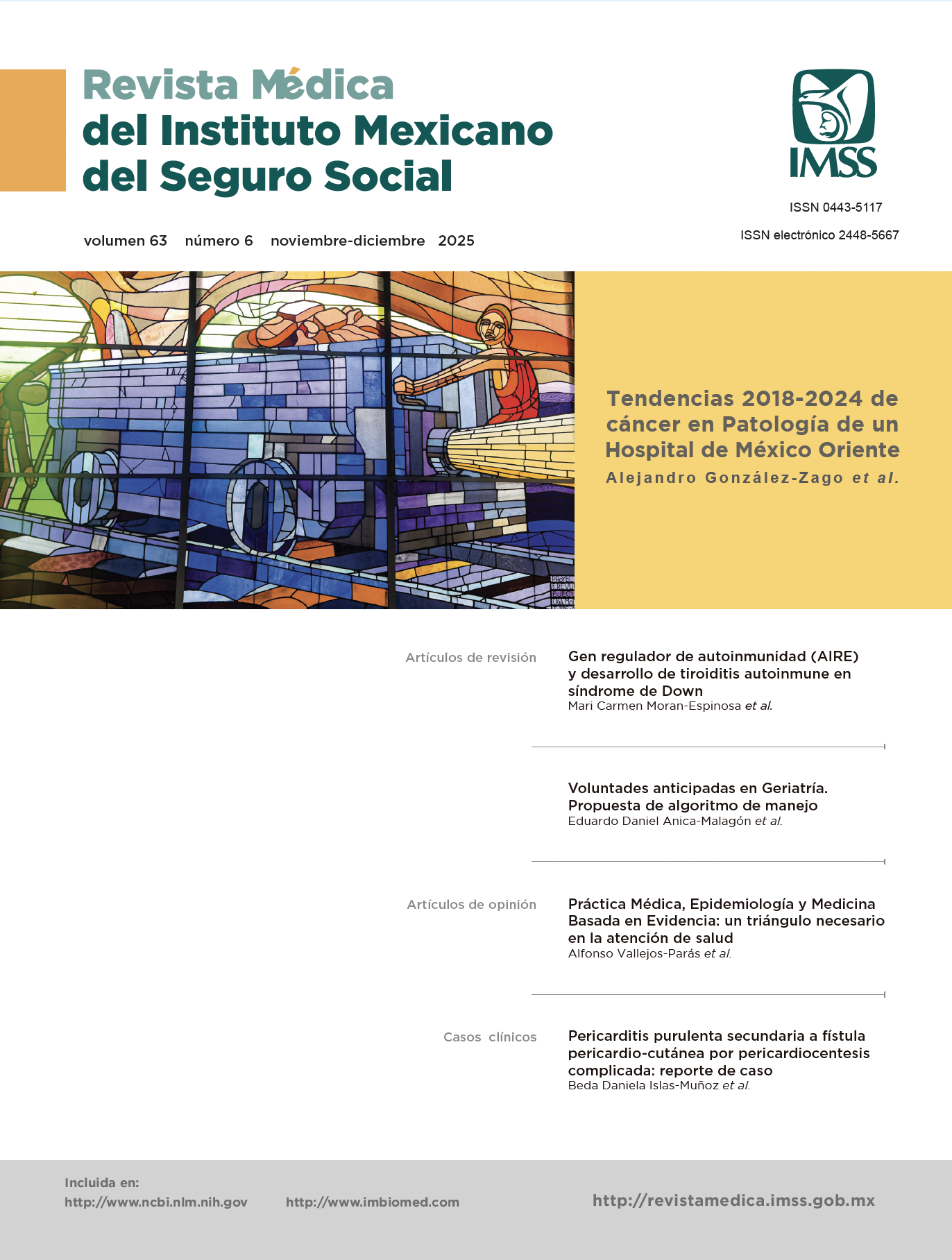Cutaneous-pericardial fistula and purulent pericarditis secondary to a complicated pericardiocentesis: Case report
Main Article Content
Keywords
Pericarditis, Cutaneous Fistula, Pericardiocentesis, Lymphoma
Abstract
Background: Cutaneous-pericardial fistulas are rare, with only isolated case reports related to infectious complications. We present here a complicated case of a patient who developed a cutaneous-pericardial fistula with secondary purulent pericarditis. We also include a review of the 15 reported cases of cutaneous-pericardial fistula in the literature.
Clinical case: A 44-year-old man diagnosed with non-Hodgkin lymphoma presenting with cardiac tamponade underwent pericardiocentesis with placement of an indwelling drainage catheter. Six weeks after catheter removal, he developed a cutaneous-pericardial fistula with purulent pericarditis, the microbiological isolation was Staphylococcus aureus methiciline susceptible (SAMS). He was admitted to the intensive care unit (ICU) with diagnosis of mixed shock (obstructive and septic) and multiple organ failure. A pericardial window was performed, and he received 8 weeks of antibiotic therapy with cepahlothin along with an integral management stablished by the ICU service. He presented a favorable outcome and resolution of infection.
Conclusions: This case illustrates a rare and serious complication with a hig risk of mortality. It is essential to strengthen monitoring and care of pericardial drains, as well as to consider early signs of infection to provide timely surgical and antimicrobial treatment.
References
1. Costa L, Carvalho D, Coelho E, et al. Purulent Pericarditis: Is It Really a Disease of the Past? Eur J Case Rep Intern Med. 2021 Jul 14;8(7):002658. doi: 10.12890/2021_002658.
2. Lee ES, Lin C, Pizula J, et al. Purulent Bacterial Pericarditis: Rare Yet Lethal. JACC Case Rep. 2024 Mar 4;29(7):102282. doi: 10.1016/j.jaccas.2024.102282.
3. Parikh S V., Memon N, Echols M, et al. Purulent pericarditis report of 2 cases and review of the literature. Medicine (Baltimore). 2009; 88(1):52–65. doi: 10.1097/MD.0b013e318194432b.
4. Choi KU, Lee CH. Purulent pericarditis: subdiaphragmatic suppurative focus. Yeungnam Univ J Med. 2020 Jan;37(1):63-66. doi: 10.12701/yujm.2019.00311.
5. Vara P, Urassa D, Temba B, et al. Chronic purulent pericarditis: case report. Pan Afr Med J. 2022 Jun 22;42:145. doi: 10.11604/pamj.2022.42.145.34018.
6. Cremer PC, Klein AL, Imazio M. Diagnosis, Risk Stratification, and Treatment of Pericarditis: A Review. JAMA. 2024 Oct 1;332(13):1090-1100. doi: 10.1001/jama.2024.12935. PMID: 39235771.
7. Latif A, Patel AD, Mahfood Haddad T, et al. Massive purulent pericarditis presenting as cardiac tamponade. Proc (Bayl Univ Med Cent). 2020 Jul 9;33(4):662-663. doi: 10.1080/08998280.2020.1783985.
8. Ben-Horin S, Bank I, Shinfeld A, et al. Diagnostic Value of the Biochemical Composition of Pericardial Effusions in Patients Undergoing Pericardiocentesis. Am J Cardiol. 2007; 99(9):1294–7.
9. Imazio M, Brucato A, Mayosi BM, et al. Medical therapy of pericardial diseases: Part I: Idiopathic and infectious pericarditis. J Cardiovasc Med. 2010; 11(10):712–22. doi: 10.2459/JCM.0b013e3283340b97.
10. Zhang RS, Singh A, Alam U, et al. Treatment of Purulent Pericarditis With Intrapericardial Alteplase. Circ Cardiovasc Imaging. 2023 Sep;16(9):e015412. doi: 10.1161/CIRCIMAGING.123.015412.
11. Dybowska M, Szturmowicz M, Lewandowska K, et al. Fibrinolytic Therapy in Purulent Pericarditis. Rev Cardiovasc Med. 2023 Jan 10;24(1):17. doi: 10.31083/j.rcm2401017.
12. Virk SA, Chandrakumar D, Villanueva C, et al. Systematic review of percutaneous interventions for malignant pericardial effusion. Heart. 2015; 101(20):1619–26. doi: 10.1136/heartjnl-2015-307907.
13. Burazor I, Imazio M, Markel G, et al. Malignant pericardial effusion. Cardiol. 2013; 124(4):224–32. doi: 10.1159/000348559.
14. Bakhriansyah J, Semita IGPG, Suryawan IGR, et al. Purulent pericarditis in advanced thymoma: A case report. Radiol Case Rep. 2022 Aug 17;17(10):3996-4000. doi: 10.1016/j.radcr.2022.07.099.
15. Peixoto CM, Souaf S, Martínez A, et al. Purulent Pericarditis as the First Manifestation of Esophageal Carcinoma. Port J Card Thorac Vasc Surg. 2024 May 13;31(1):59-62. doi: 10.48729/pjctvs.423.
16. Tsang TSM, Enriquez-Sarano M, Freeman WK, et al. Consecutive 1127 therapeutic echocardiographically guided pericardiocenteses: Clinical profile, practice patterns, and outcomes spanning 21 years. Mayo Clin Proc. 2002; 77(5):429–36. doi: 10.4065/77.5.429.
17. Lin RY, Schwartz RA, Lambert WC. Cutaneous-pericardial tuberculous fistula in an immunocompromised host. Int J Dermatol. 1986 Sep;25(7):456-8. doi: 10.1111/j.1365-4362.1986.tb03453.x.
18. Baltasar L, Ruiz V, Berjón J, et al. Purulent Pericarditis Complicated by Cardiac Tamponade Secondary to a Hydatid Cyst-Associated Hepatic Abscess. Revista Española de Cardiología. 2009;62(8): 948-949. doi:10.1016/s1885-5857(09)72666-0.
19. Pasic M, Unbehaun A, Drews T, et al. Late wound healing problems after use of BioGlue for apical hemostasis during transapical aortic valve implantation. Interact Cardiovasc Thorac Surg. 2011;13(5):532-4. doi: 10.1510/icvts.2011.276360.
20. Baillot R, Fréchette É, Cloutier D, et al. Surgical site infections following transcatheter apical aortic valve implantation: incidence and management. J Cardiothorac Surg. 2012;7:122. doi: 10.1186/1749-8090-7-122.
21. Scheid M, Grothusen C, Lutter G, et al. Cutaneo-pericardial fistula after transapical aortic valve implantation. Interact Cardiovasc Thorac Surg. 2013; 16(4):558-9. doi: 10.1093/icvts/ivs511.
22. Narala K, Banga S, Gayam S, et al. Cutaneo-Pericardial Fistula After Transapical Approach for Transcatheter Aortic Valve Replacement. JACC Cardiovasc Interv. 2016 Apr 11;9(7):747-9. doi: 10.1016/j.jcin.2015.12.020.
23. Khan HR, Ansari MI, Varcoe RW, et al. Pulsatile sterile abscess in the left breast following transapical transcatheter aortic valve implantation: a case report. Eur Heart J Case Rep. 2019;3(2):ytz032. doi: 10.1093/ehjcr/ytz032.
24. Tarus A, Enache M, Nedelciuc I, et al. Cutaneous-Pericardial Fistula: Rare Complication of Transapical Aortic Valve Replacement-Case Report and Literature Review. Case Rep Surg. 2020;2020:2371423. doi: 10.1155/2020/2371423.
25. Ali M, Pham AN, Martinez JM, et al. Use of Omental Flap for Treating Cardiocutaneous Fistula After Ventricular Aneurysm Repair. Ann Thorac Surg. 2020 Aug;110(2):e127-e128. doi: 10.1016/j.athoracsur.2019.11


